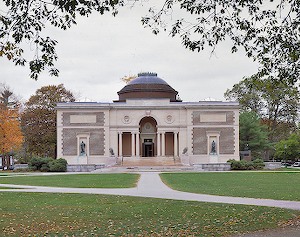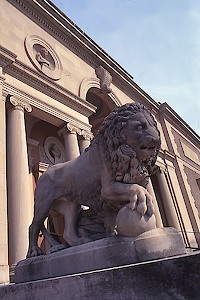History


The Museum’s façade is based on Renaissance prototypes with a grand stair leading to a dramatically shadowed loggia. On either side are bronze statues of Sophocles and Demosthenes, copies by Sabatino de Angelis, a nineteenth-century Neapolitan sculptor of ancient originals. Two large lions, taken from those at the Loggia dei Lanzi in Florence, stand guard on either side of the stair.
The Museum’s original interior consisted of a central rotunda surrounded by three tall, skylit galleries on the entrance level. The dramatic rotunda is capped by a high coffered dome, below which are four large semicircular murals by the leading painters of the American Renaissance: Elihu Vedder, Kenyon Cox, Abbott Thayer and John LaFarge. The mural scheme called for each artist to paint an allegorical representation of one of the four cities perceived at the time as most central to the development of western art. The paintings were commissioned by McKim, who believed in the unity of the arts, and constitute an extremely important ensemble of architectural decoration.
In 1974 the Museum’s lower-level spaces were renovated and expanded, when Art Department offices and activities moved next door to the Edward Larrabee Barnes-designed Visual Arts Center.
The Museum’s 2005-2007 renovation respects the history and integrity of the original building, while providing new spaces and systems in keeping with twenty-first-century standards.

